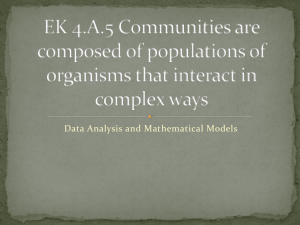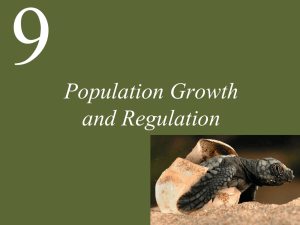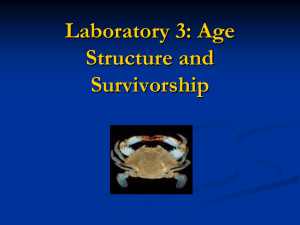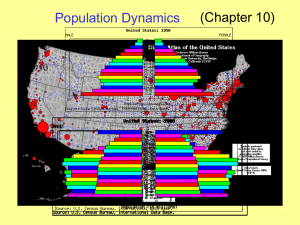10 - Dr. Mark Pyron
advertisement
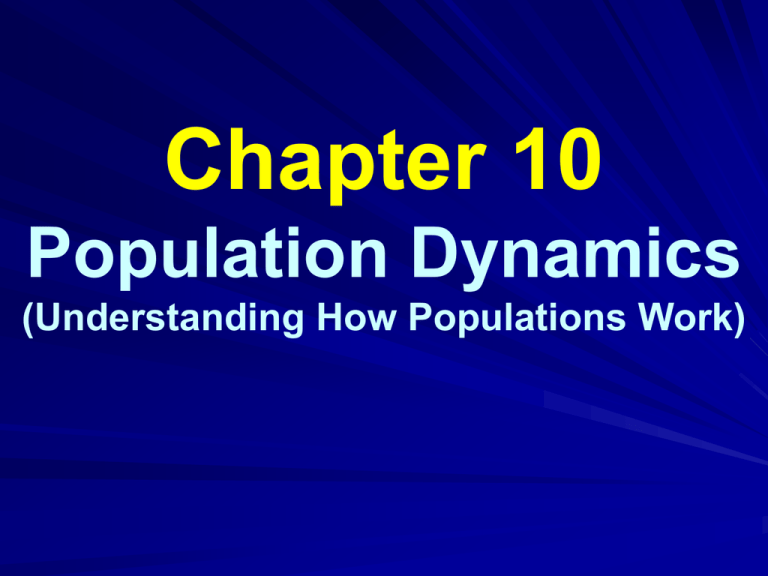
Chapter 10
Population Dynamics
(Understanding How Populations Work)
Chapter 10
Population Dynamics
(Understanding How Populations Work)
What Processes Determine
Current Population Size?
Population size in earlier time period (Nt-1)
Number of births (B)
Number of deaths (D)
Number of immigrants (I)
Number that emigrate (E)
Nt = Nt-1 + (B−D) + (I−E)
Dynamics of Death
Survivorship
Age-Specific Survivorship (Lx)
Def: The proportion of individuals born into a
population that survive to a specified age x.
Lx
=
nx / n0
x = age,
nx = number of individuals surviving to age x.
n0 = number of individuals born into
population in a single time period (Cohort)
Cohort Survivorship
Mark all individuals born in a single year
(called a cohort). n0
Each year, count the number of surviving
individuals in the cohort. nx
Lx = proportion of original cohort still alive
for each age class = x. = nx / n0
Example Calculations for Cohort
Survivorship
Age
Class
Number of
Survivors ( nx ) Survivorship ( Lx )
0
653
1.000
1
325
0.497
= 325 / 653
2
163
0.250
= 163 / 653
3
81
0.124
= 81 / 653
4
35
0.054
= 35 / 653
Survivorship From Age-at-Death
Determine age-at-death for a sample of
dead organisms.
Often based on annual growth structures.
– Annual tree rings
– Annual layers in fish scales and ear bones
– Enamel layers in bear teeth
– Ridges on horns of Dall sheep
Computing Survivorship From
Age-at-Death
Age How Many Died Number of
Survivorat That Age
Survivors (nx) ship (Lx)
Class
0
223
530
1.000
1
145
307
= 530-223
0.579
2
89
162
= 307-145
0.306
3
58
73
= 162-89
0.138
4
15
15
= 73-58
0.028
Total
530
Computing Survivorship From
Age-at-Death
Age How Many Died Number of
Survivorat That Age
Survivors (nx) ship (Lx)
Class
0
223
530
1.000
1
145
307
= 530-223
0.579
2
89
162
= 307-145
0.306
3
58
73
= 162-89
0.138
4
15
15
= 73-58
0.028
Total
530
Three Types of Survivorship Curves
Logarithmic
Scale
Mortality due to
predation affects old
more than young)
Type 2 Survivorship Curve:
Constant Mortality Rate
Winter mortality due
to freezing affects all
ages equally
Mortality due to
environment
affects all ages
equally
Type 3 Survivorship Curve:
Perennial Plant Species
Mortality due to predation
affects seeds and
seedlings more than
mature plants
Dynamics of Birth
Age-Specific Birth Rate (mx)
Definition: The average number of young
born to female organisms of a specific age x.
From direct observation of number of young
produced by females.
Fecundity schedule: Age-specific birth rates
for entire lifetime.
Interactions Between
Survivorship and Birth Rates
Net Reproductive Rate (R0)
Definition: Average offspring from an
individual organism during entire
lifetime.
R0 = Sum for all age classes {Lx mx}
WHERE: x = age and Lx and mx are age-specific
survivorship and birth rates.
Computing Net Reproductive
Rate (R0)
Age Survivorship Birth Rate
Class
Lx
mx
Lx mx
0
1.000
0
0
1
0.579
5
2.95
2
0.306
10
3.06
3
0.138
11
1.52
4
0.028
9
0.26
Total
R0 =
7.79
Generation Time ( T )
Definition: Average time from birth to
when it reproduces.
= average age of mothers
T = Sum (Age)(Lx)(mx) / R0
Computing Generation Time (T)
Age
(X)
0
Survivorship Birth Rate
Lx
mx
1.000
0
Lx mx X Lx mx
0
0
1
0.579
5
2.95
2.95
2
0.306
10
3.06
6.12
3
0.138
11
1.52
4.56
4
0.028
9
0.26
1.04
7.79
14.67
Total
R0 =
T = 14.67 / 7.79 = 1.88
Per Capita Rate of Increase (r)
The difference Birth Rate − Death Rate
+ r means births exceed deaths, so
population size is increasing.
− r means births are less than deaths,
population size is decreasing.
Estimating r From a Life Table
r = Ln (R0) / T
“Ln” indicates the
natural logarithm
function.
Generation
Time
Net
Reproductive
Rate
End of Part 1:
Population Dynamics
Population Dynamics
Part 2
Understanding Population
Growth Rate
r
=
Ln
(R
0)
_____
T
High net reproductive rate results in high r
(rapid population growth)
Small generation time results in high r .
Effect of Generation Time
20 yrs
20 yrs
60 yrs
20 yrs
Effect of Generation Time
30 yrs
30 yrs
60 yrs
Effect of Net Reproductive Rate
How to Increase R0 = Sum Lx mx?
Increase survivorship: Longer-lived
individuals have more opportunities for
reproduction during life time.
How to Increase R0 = Sum Lx
mx?
Increase survivorship: Longer-lived
individuals have more opportunities for
reproduction during life time.
Increase birth rates: Increase number of
offspring produced by individuals in
each age class.
Question: Can an organism do both ???
How to Decrease T ?
Rapid Growth Rate: Organisms reach
sexually mature body size sooner.
Question: What is required to do this ?
Reproduce at a smaller body size:
Less time required to reach sexual
maturity.
Any disadvantages to this ?
How to Decrease T ?
Rapid Growth Rate: Organisms reach
sexually mature body size sooner.
Question: What is required to do this ?
Reproduce at a smaller body size:
Less time to reach sexual maturity.
Any disadvantages to this ?
Body Size and
Generation Time
Larger species take
longer to grow to
mature size.
Larger species often
reproduce throughout
long life span.
Higher average age
of reproducing
individuals
Trade – Offs
(Assuming Limited Resources)
Allocating resources to reproduction
reduces resources available for adult
survivorship (immune system, fat
reserve).
mx
Lx
Trade - Offs
Reproducing at an earlier age (smaller
body size) means more individuals
reproduce before they die.
Trade - Offs
Reproducing at an earlier age (smaller
body size) means more individuals
reproduce before they die.
However:
– Small adults produce small offspring with
lower Lx than large offspring.
– Smaller parents and offspring at
disadvantage in competition for resources
with larger individuals (lower Lx and mx)
r - vs K - Selected Life History
r - selected traits
– Short generation time
– Small adult body size
– Short life span
– High birth rates
– Small offspring
– Low survivorship of
offspring
– Low Parental Care
– Type III Survivorship
K - selected traits
– Long generation time
– Large adult body size
– Long life span
– Low birth rates
– Large offspring
– High survivorship of
offspring
– High Parental Care
– Type I Survivorship
Dispersal
(Immigration and Emigration)
Causes of Dispersal
– Over-population and depletion of resources
– Environmental change alters habitat quality
– Organisms carried by wind or water currents
– Spatial/Temporal variation in resources
– Human transport
Importance of Dispersal
Gene flow among separate populations
Re-colonization of empty habitats
Enhances utilization of shifting or
ephemeral resources
PROBLEM: Exotic species
Dispersing/sedentary stages of organisms
Northward Expansion of Tree Species After
Continental Glaciers Receded 12,000 yrs BP
Exotic Species:
Invasion of Africanized
Honeybees
Expansion of Collared
Doves into Europe
Due to occasional long-distance
dispersal of young doves in
search of new territories.
Why did the collared dove not
occur in Europe before ???
The End
